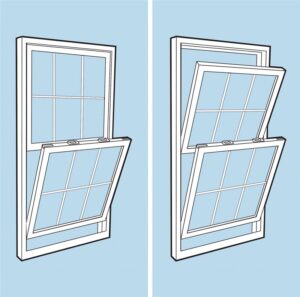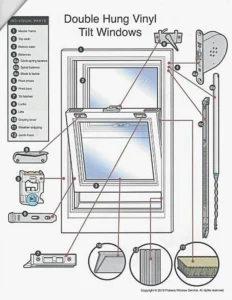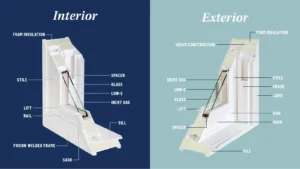When it comes to selecting new windows for your home, the choice between double hung and single hung windows is a common dilemma. Both styles have their own unique advantages and potential drawbacks. Understanding these can help you make an informed decision that’s right for your home renovation or DIY project.
Double Hung Windows
Pros
- Versatility and Ventilation:
- Top and Bottom Sashes: In double hung windows, both the upper and lower sashes can be opened. This allows for more efficient ventilation as warm air can escape from the top while cool air enters through the bottom.
- Ease of Cleaning:
- Tilt-In Feature: Many double hung windows are designed with tilt-in sashes. This feature makes cleaning both the interior and exterior of the window pane more convenient, especially for upper floors.
- Enhanced Aesthetics:
- Balanced Look: The symmetry of double hung windows offers a classic and balanced look, making them suitable for various architectural styles.
Cons
- Higher Cost:
- Initial Investment: Double hung windows generally cost more upfront compared to single hung windows. The additional functionality and features contribute to the higher price tag.
- More Maintenance:
- Additional Moving Parts: With two operable sashes, double hung windows have more moving parts, which may require more maintenance over time to ensure smooth operation.
- Potential Energy Efficiency Issues:
- Air Leakage: If not properly sealed, double hung windows can potentially have more points of air leakage, impacting energy efficiency.
Single Hung Windows 
Pros
- Cost-Effective:
- Lower Initial Cost: Single hung windows are generally less expensive than double hung windows, making them a budget-friendly option for many homeowners.
- Simpler Design:
- Fewer Moving Parts: With only the lower sash operable, single hung windows have fewer moving parts, which can translate to lower maintenance needs over time.
- Energy Efficiency:
- Fewer Seals: The fewer operable parts in single hung windows often mean fewer seals that can potentially fail, which can help maintain energy efficiency in the long term.
Cons
- Limited Ventilation:
- One Movable Sash: Only the bottom sash of single hung windows can be opened, limiting ventilation options compared to double hung windows.
- Cleaning Challenges:

- Fixed Upper Sash: Cleaning the exterior of the upper sash can be difficult, especially on higher floors, as it does not tilt inwards like some double hung windows.
- Less Versatility:
- Fixed Design: The fixed upper sash can limit the overall versatility and aesthetic appeal of the window, potentially making it less suited to certain design styles or functional needs.
Which Window is Right for You?
Choosing between double hung and single hung windows ultimately depends on your specific needs, preferences, and budget. Here are a few questions to consider:
- Budget: Are you looking for the most cost-effective solution, or are you willing to invest more for added features and versatility?
- Functionality: Do you need enhanced ventilation and ease of cleaning, particularly for upper floors?
- Aesthetics: Which window style better complements the architectural design of your home?
By weighing the pros and cons, you can make an informed decision that aligns with your home renovation goals.
For Tons of Great Free Information please hit “Like & Subscribe”
Websiteconstructionconsumeradvocacyinstitute.com
Podcastanchor.fm/galloway
www.youtube.com/@ConstructionConsumerAdvocacy
Conclusion
Both double hung and single hung windows have their unique benefits and potential drawbacks. Whether you’re a homeowner planning a renovation, a DIY enthusiast tackling a new project, or a renovator looking to upgrade a property, understanding these differences is crucial.
If you’re still unsure which option is best for you, consulting with a window professional can provide additional insights tailored to your specific situation.
Happy renovating!



